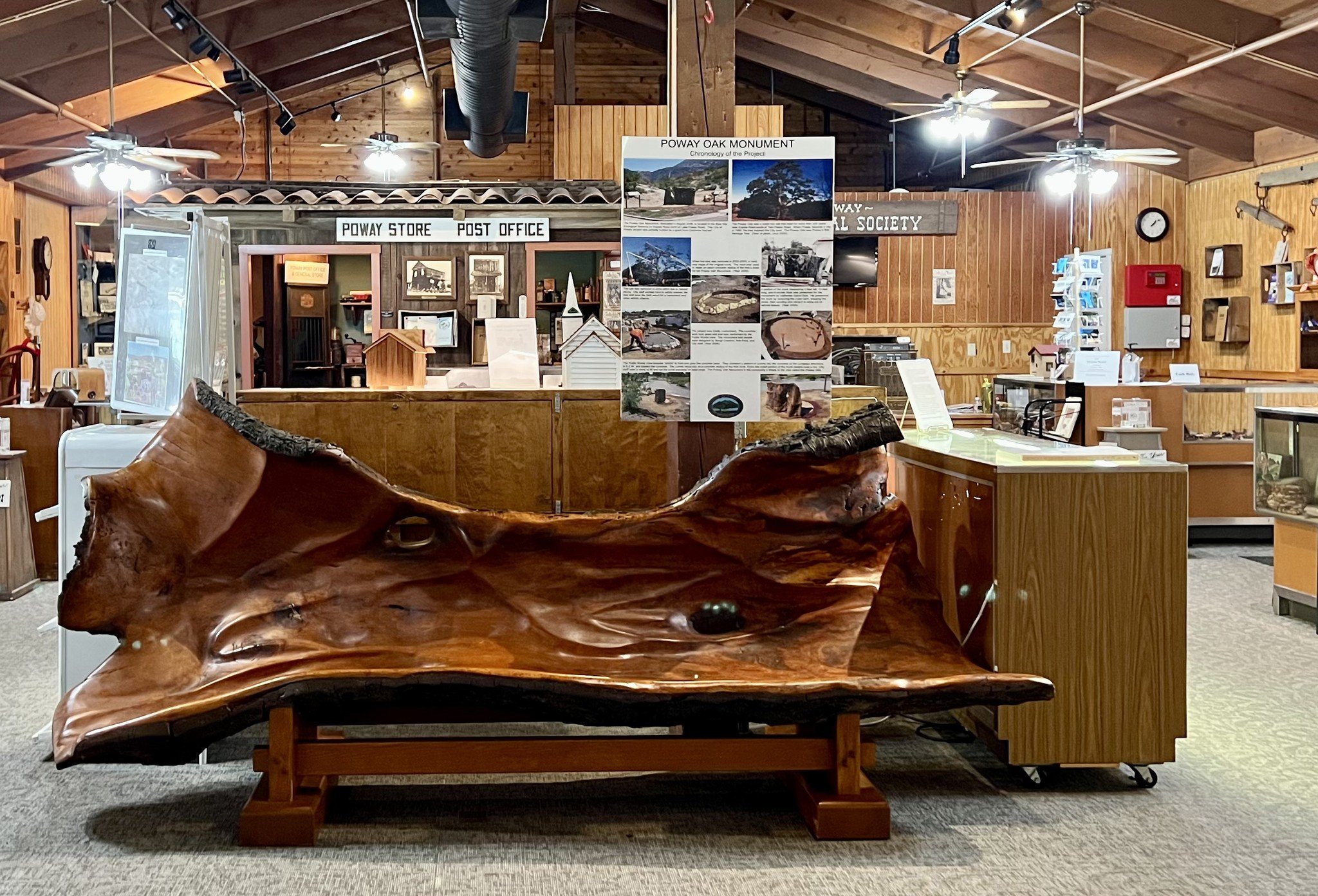Poway’s Historical Timeline
Below is a snapshot of the chronological history of Poway.
Native Period Pre-1769
Native American peoples called the Kumeyaay (koo-mee-EYE) lived throughout what is now San Diego County and Baja California. The name Poway is derived from the Kumeyaay word “Pauwai”, which is generally accepted to mean both the shape of an arrowhead and also where two valleys meet, referring to the topography of the land.
The Kumeyaay lived in thatched shelters called “ewaa” and had many uses for local plant life, especially acorns and the agave plant. They had sophisticated agriculture, plant and animal husbandry practices that were evident by the time the Spanish arrived, such as maintaining wild animal stocks, controlling erosion and overgrowth, building dams, and creating watersheds for storing groundwater. The Kumeyaay are known for their basket weaving and pottery, some of which are on display in the Poway Heritage Museum.
5,800 years ago – Early arrivals
3,400 years ago – Permanent native villages
1,500 years ago – The Kumeyaay are the dominant population until the arrival of white settlers
1542 – The coastal Kumeyaay first encountered European explorer Juan Rodriquez Cabrillo when his ship sailed into San Diego Bay
Spanish and Franciscan Mission Period 1769-1821
Since 1542, the Spanish had explored coastal San Diego and interacted with native populations, but didn’t create their first settlement until much later. Inland areas, including Poway, were still predominantly inhabited by the native people, but soon saw Spanish expansion.
1769 – The first European settlement on the California coast was founded as a small Spanish colony with Father Junípero Serra establishing what would become the first of 21 Spanish missions in the region (Mission San Diego de Alcalá)
Cattle from the San Diego Mission grazed in the Pauwai Valley as Spanish conquest moved eastward
Mission Indians and Kumeyaay begin joining together
1810 – Beginning of the Mexican War of Independence, which had an impact on lands that would eventually become San Diego County
Mexican Period 1821-1848
After Spain’s defeat in the Mexican War of Independence, much of the land in what is now California was awarded as land grants to Mexican settlers, called “Californios”, by the Mexican government. A man named Rosario Aguilar applied to become the Mexican Governor for Rancho Paguay (the Spanish spelling of Pauwai/Poway), but he never did what was needed to take over the land.
1821 – The Mexican Empire assumed ownership of Kumeyaay lands after defeating Spain in the Mexican War of Independence
Cattle grazing still continues until Mexico takes over mission lands and property
1830 – Rosario Aguilar applies for the land grant of Rancho Paguay
Land grant never finalized due to lack of completion of requirements
1846 – Beginning of the Mexican-American War
1848 – Mexican-American War ends with Mexico’s defeat and the signing of the Treaty of Guadalupe Hidalgo, requiring several territories previously held by the Mexican government, including California, to be ceded to the United States
Early California Statehood and Pioneer Period 1849-1900
Since the land grant to Aguilar was never completed and California was no longer part of Mexico, land ownership in Poway was awarded to homesteaders who settled and developed it. Soon, more and more families came to build homes and farms in the fertile valley, with businesses and churches being constructed to serve the growing population.
Developers plan to bring a railroad through the center of town, where Old Poway is now
1850 – California becomes the 31st state
1859 – Phillip Crosthwaite, believed to be the first white settler in Poway, built a home where Creekside Plaza now stands
More homesteaders began to arrive in the Poway Valley
1870 – The first post office opens
1882 – Dr. Louis N. Hilleary arrives in Poway, becoming the town’s first medical doctor
1890 – The beginning of a real estate boom fueled by the prospect of the railroad coming through town and the valley really began growing
When the proposed railroads did not come, the valley lost much of its population
Farming Period 1900-1955
Farming started to become more dominant and free-ranging cattle left the Poway Valley. Peaches and grapes became the main crops, although many others were grown here. Farmers sold their produce in San Diego.
Farming becomes the main occupation in Poway, with many types of crops such as fruits and grains being grown, as well as dairy farms
Population increased greatly as Poway became known for its agriculture
Toward Cityhood 1955-1980
Rainfall and wells still provided the water needed for Poway farms, however when droughts hit, crops failed and farmers suffered. Residents began looking for a new and permanent source of water for the town, which paved the way for future growth.
1954 – The residents voted to form the Poway Municipal Water District, Bringing water from the Colorado River aqueduct
1957 – Sewer system and treatment plant was developed
1958 – The presence of water and sewer meant that tract homes could be built, beginning with Poway Valley Homes along Pomerado Rd.
Population growth increases tremendously as new schools, housing tracts, roads, and shopping are built
Poway remains an unincorporated community, governed by the County of San Diego
1980 - Present
Though Poway’s status as a city is still relatively recent, its history is vibrant and ongoing.
1980 - Poway residents vote to incorporate as the City of Poway

Find Out More at the Poway
Heritage Museum
If you’re eager to learn more about what life was like in early Poway, come visit the Poway Heritage Museum to see exhibits featuring artifacts, photos, and more! Admission is free to the public and is a great way to enjoy a unique and educational experience that’s fun for all ages.
Open Saturdays 10AM-2PM and Sundays 11AM-2PM
(Closed second Sunday of each month)
Free Admission



